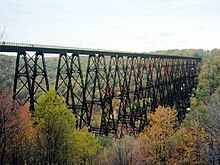The Pennsylvania Portal
The coat of arms of Pennsylvania Pennsylvania lit. ' Penn's forest country ' ), officially the Commonwealth of Pennsylvania (Pennsylvania Dutch : Pennsylvanie state spanning the Mid-Atlantic , Northeastern , Appalachian , and Great Lakes regions of the United States . Pennsylvania borders Delaware to its southeast, Maryland to its south, West Virginia to its southwest, Ohio and the Ohio River to its west, Lake Erie and New York to its north, the Delaware River and New Jersey to its east, and the Canadian province of Ontario to its northwest.
Pennsylvania was founded in 1681 through a royal land grant to William Penn , the son of the state's namesake . Prior to that, between 1638 and 1655, a southeast portion of the state was part of New Sweden , a Swedish Empire colony. Established as a haven for religious and political tolerance, the colonial-era Province of Pennsylvania was known for its relatively peaceful relations with native tribes, innovative government system , and religious pluralism . Pennsylvania played a vital and historic role in the American Revolution and the ultimately successful quest for independence from the British Empire , hosting the First and Second Continental Congress leading to the adoption of the Declaration of Independence . On December 12, 1787, Pennsylvania became the second state to ratify the U.S. Constitution . The bloodiest battle of the American Civil War , at Gettysburg over three days in July 1863, proved the war's turning point, leading to the Union's preservation . Throughout the late 19th and 20th centuries, the state's manufacturing-based economy contributed to the development of much of the nation's early infrastructure, including key bridges, skyscrapers , and military hardware used in U.S.-led victories in World War I , World War II , and the Cold War .
Pennsylvania's geography is highly diverse. The Appalachian Mountains run through the center of the state; the Allegheny and Pocono mountains span much of Northeastern Pennsylvania ; close to 60% of the state is forested . While it has only 140 miles (225 km) of waterfront along Lake Erie and the Delaware River, Pennsylvania has the most navigable rivers of any state in the nation, including the Allegheny , Delaware, Genesee , Ohio , Schuylkill , Susquehanna , and others. (Full article...
This is a Featured article , which represents some of the best content on English Wikipedia.. One of only two confirmed photos of
Lincoln (seated in center facing camera) at
Gettysburg taken about noon on November 19, 1863; Lincoln spoke some three hours later. To Lincoln's right is
Ward Hill Lamon , his bodyguard.
The Gettysburg Address speech that U.S. President Abraham Lincoln delivered during the American Civil War at the dedication of the Soldiers' National Cemetery , now known as Gettysburg National Cemetery, in Gettysburg, Pennsylvania on the afternoon of November 19, 1863, four and a half months after the Union armies defeated Confederate forces in the Battle of Gettysburg , the Civil War's deadliest battle. It remains one of the most notable and famous speeches in American history .
Lincoln's carefully crafted and brief address, which was not scheduled as the day's primary speech, came to be seen as one of the greatest and most influential statements on the American national purpose. In just 271 words, beginning with the now famous phrase "Four
score and seven years ago", referring to the signing of the
Declaration of Independence 87 years earlier, Lincoln described the U.S. as a nation "conceived in Liberty, and dedicated to the proposition that
all men are created equal " and represented the Civil War as a test that would determine whether such a nation could endure. Lincoln extolled the sacrifices of those who died at Gettysburg in defense of those principles and then urged that the nation ensure: (
Full article... )
List of Featured articles
The bridge before its collapse
The Kinzua Bridge Kinzua Viaduct (, ) was a railroad trestle that spanned Kinzua Creek in McKean County in the U.S. state of Pennsylvania . The bridge was 301 feet (92 m) tall and 2,052 feet (625 m) long. Most of its structure collapsed during a tornado in July 2003.
Billed as the "
Eighth Wonder of the World ", the
wrought iron original 1882 structure held the record for the tallest railroad bridge in the world for two years. In 1900, the bridge was dismantled and simultaneously rebuilt out of steel to allow it to accommodate heavier trains. It stayed in commercial service until 1959, when it was sold to a salvage company. In 1963 the
Commonwealth of Pennsylvania purchased the bridge as the centerpiece of a state park. (
Full article... )
List of geography articles
Johnstown, Pennsylvania Scranton, Pennsylvania Pittsburgh Philadelphia Bethlehem, Pennsylvania Allentown, Pennsylvania Lancaster, Pennsylvania State College, Pennsylvania Warren, Pennsylvania DuBois, Pennsylvania Erie, Pennsylvania Chambersburg, Pennsylvania Juniata County, Pennsylvania Pithole, Pennsylvania Lock Haven, Pennsylvania Larrys Creek State Route 1002 (Lehigh County, Pennsylvania) Pennsylvania Route 563 Hull Creek (Lackawanna River tributary) Little Fishing Creek Ganoga Lake Mahoning Creek (Susquehanna River tributary) Shawnee on Delaware, Pennsylvania Roaring Brook (Lackawanna River tributary) Pennsylvania Route 463 Kettle Creek (Pennsylvania) Spanish Hill West Branch Fishing Creek West Creek (Pennsylvania) Plunketts Creek Bridge No. 3 White Deer Hole Creek Plunketts Creek (Loyalsock Creek tributary) Horseshoe Curve (Pennsylvania) Quehanna Wild Area Harrisburg, Pennsylvania Levittown, Pennsylvania Pennsylvania Turnpike Pocono Mountains Altoona, Pennsylvania
Related portals
Wikiprojects
This is a Good article , an article that meets a core set of high editorial standards. Emily Sartain (March 17, 1841 – June 17, 1927) was an American painter and engraver. She was the first woman in Europe and the United States to practice the art of
mezzotint engraving, and the only woman to win a gold medal at the
1876 World Fair in Philadelphia . Sartain became a nationally recognized art educator and was the director of the
Philadelphia School of Design for Women from 1866 to 1920. Her father,
John Sartain , and three of her brothers,
William , Henry and Samuel were artists. Before she entered the
Pennsylvania Academy of the Fine Arts and studied abroad, her father took her on a
Grand Tour of Europe. She helped found the
New Century Club for working and professional women, and the professional women's art clubs,
The Plastic Club and The Three Arts Club. (
Full article... )
Pennsylvania news
Categories
Category puzzle Select [►] to view subcategories
State facts
State Facts Pennsylvania's largest city Philadelphia Nickname: The Keystone State Capital: Harrisburg Largest city: Philadelphia Total area: 119,283 square kilometers (46,055 square miles)Population (2000 census): 12,281,054Date admitted to the Union: December 12, 1787 (2nd )State symbols Mountain laurel, Pennsylvania's state flower
Pennsylvania topics
General images
The following are images from various Pennsylvania-related articles on Wikipedia.
Image 1 The
Stonycreek Township crash site of
Flight 93 , one of four planes hijacked in the
September 11 attacks ; the site is now a
national memorial . Flight 93 passengers wrestled with
al-Qaeda terrorist hijackers for control of the plane, preventing it from being flown into the
White House or
U.S. Capitol . (from
Pennsylvania )
Image 3 Bethlehem Steel in
Bethlehem was one of the world's leading steel manufacturers for most of the 19th and 20th century. In 1982, however, it discontinued most of its operations, declared bankruptcy in 2001, and was dissolved in 2003. (from
Pennsylvania )
Image 4 The Birth of Pennsylvania , a portrait of
William Penn (standing with document in hand), who founded the
Province of Pennsylvania in 1681 as a refuge for
Quakers after receiving a royal deed to it from
King Charles II (from
History of Pennsylvania )
Image 6 Pat's King of Steaks in
South Philadelphia is widely credited with inventing the
cheesesteak in 1933 (from
Pennsylvania )
Image 7 Pennsylvania's unemployment rate between 1976 and 2021
The U.S. unemployment rate during these years
(from
Pennsylvania )
Image 8 Shelter House in
Emmaus , constructed in 1734 by
Pennsylvania German settlers, is the oldest continuously occupied building structure in the
Lehigh Valley and one of the oldest in Pennsylvania (from
Pennsylvania )
Image 9 Ethnic origins of Pennsylvanians (from
Pennsylvania )
Image 11 On November 19, 1863,
President Abraham Lincoln (center, facing camera) arrived in
Gettysburg and delivered the
Gettysburg Address , considered one of the best-known speeches in American history. (from
Pennsylvania )
Image 12 The
Philadelphia Eagles are presented with the
Vince Lombardi Trophy after winning
Super Bowl LII on February 4, 2018 (from
Pennsylvania )
Image 14 Simon Cameron of
Maytown was
Secretary of War and head of Pennsylvania's
Republican Party , whose party machine controlled Pennsylvania into the 20th century. (from
History of Pennsylvania )
Image 15 Pittsburgh Steelers ' fans waving the
Terrible Towel , a tradition that dates back to
1975 (from
Pennsylvania )
Image 20 The
Battle of Gettysburg , fought July 1–3, 1863 in
Gettysburg , was the Civil War's
deadliest battle but also is widely considered the
war's turning point in the
Union's ultimate victory. The battle is depicted in this 1887
Thure de Thulstrup painting,
Battle of Gettysburg . (from
Pennsylvania )
Image 21 Citizens Bank Park in
South Philadelphia , home of the
Philadelphia Phillies , the oldest continuous same-name, same-city franchise in American professional sports (from
Pennsylvania )
Image 22 Stephen Decatur , a 19th-century
naval commander who served in the
War of 1812 and other engagements (from
History of Pennsylvania )
Image 24 2020 U.S. presidential election results by county in Pennsylvania
Democratic
Republican
(from
Pennsylvania )
Image 25 The locomotive
Tioga in
Philadelphia in 1848; Pennsylvania was an important railroad center throughout the 19th century. (from
History of Pennsylvania )
Image 27 Philadelphia International Airport , the busiest airport in the state and the
21st-busiest airport in the nation with nearly 10 million passengers annually as of 2021 (from
Pennsylvania )
Image 29 Dorney Park & Wildwater Kingdom 's
Steel Force and
Thunderhawk roller coasters in
Allentown ; Steel Force is the eighth-longest
steel roller coaster in the world with a first drop of 205 feet (62 m) and a top speed of 75 miles per hour (121 km/h). (from
Pennsylvania )
Image 30 The
Gettysburg campaign , which culminated in the
Battle of Gettysburg , was a major turning point in the
American Civil War and the war's bloodiest battle with an estimated 46,000 to 51,000 casualties (from
History of Pennsylvania )
Image 31 One of only two confirmed photos of
Abraham Lincoln (sitting in center, facing camera, without his traditional top hat) at
Gettysburg a few hours prior to giving the
Gettysburg Address at
Gettysburg National Cemetery on November 19, 1863. The address, which was only 271 words in length, ranks among the most famed speeches in American history. (from
History of Pennsylvania )
Image 33 An
Amish family riding in a traditional
Amish buggy in
Lancaster County ; Pennsylvania has the largest
Amish population of any state. (from
Pennsylvania )
Image 34 The
statue of
Benjamin Franklin on the campus of the
University of Pennsylvania , an
Ivy League institution in
Philadelphia ranked one of world's top universities (from
Pennsylvania )
Image 35 Köppen climate types in Pennsylvania (from
Pennsylvania )
Image 36 A map of
New Netherland (in magenta) and
New Sweden (in blue) in the 17th century; New Sweden was later absorbed by New Netherland and then the
British in the
Second Anglo-Dutch War . (from
History of Pennsylvania )
Image 39 The
colonial possessions of
Britain (in pink),
France (in blue), and
Spain (in orange) as of 1750. The French later lost their possessions in
North America to Britain following its defeat in the
French and Indian War , fought from 1754 to 1763 (from
History of Pennsylvania )
Associated Wikimedia
The following Wikimedia Foundation sister projects provide more on this subject:
Commons
Wikibooks
Wikidata
Wikinews
Wikiquote
Wikisource
Wikiversity
Wikivoyage
Wiktionary









































































Recent Comments